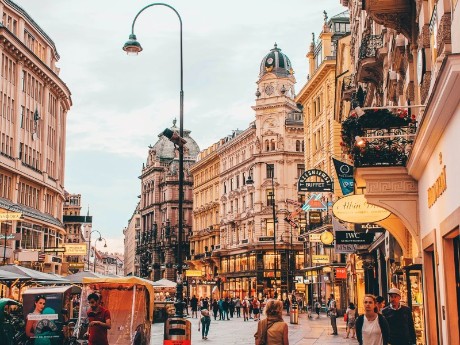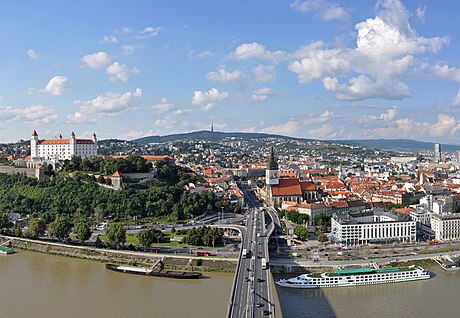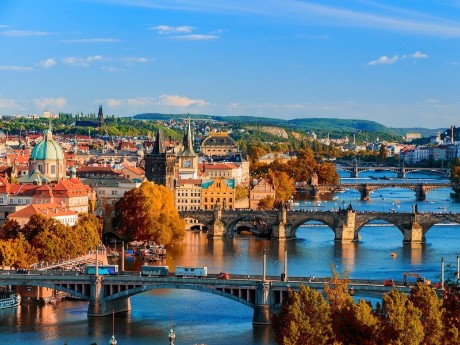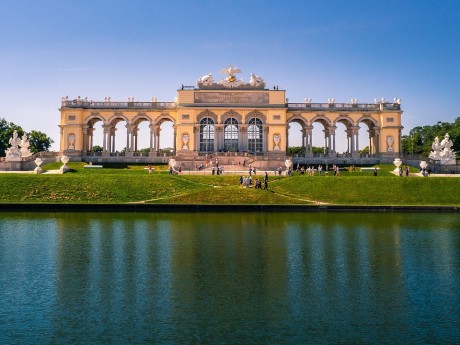Central Europe: Slovakia, Austria & Czech Republic
Beginning in Vienna, Austria, the Schönbrunn Palace is its most impressive attraction which used to be the main summer residence of the Habsburg rulers. The baroque styled St. Stephen's Cathedral is an architectural marvel. Don't miss the renowned Vienna Operahouse with nearly 300 yearly performances. Next is Bratislava, the thriving capital of Slovakia with its iconic Bratislava Castle which housed Celtic, Moravian and Hungarian rulers for centuries.
Read more
Beginning in Vienna, Austria, the Schönbrunn Palace is its most impressive attraction which used to be the main summer residence of the Habsburg rulers. The baroque styled St. Stephen's Cathedral is an architectural marvel. Don't miss the renowned Vienna Operahouse with nearly 300 yearly performances. Next is Bratislava, the thriving capital of Slovakia with its iconic Bratislava Castle which housed Celtic, Moravian and Hungarian rulers for centuries. The Hrad Devín is another castle that shows the country's oldest traces of Slavic settlement, from the ninth century, and Michael's Gate is the city's only preserved gate with medieval fortifications. Lastly in Prague, Czechia's capital, visit the Prague Castle built in the 9th century, still used now as the official office of the President. The Old Town Square, built in the 10th century along with Charles Bridge are must see attractions. The St. Vitus Cathedral is the well-known in the country, used for the coronations of Czech monarchs and for its beautiful interior. Waterviews strives to offer accommodation options within walking distance of water and/or in an area of touristic interest. Our prices include taxes (but excludes local tourist taxes). Customize your trip to your personal preferences with optional activities (hit the “Add Activities’’) or change hotels, etc. Contact us for customization at no extra cost at: Service@waterviewstravel.com
Destinations
- Vienna
- Bratislava
- Prague
Itinerary
Vienna

Austria’s capital is pure elegance; Imperial Palaces sit alongside sprawling museums, grand coffee houses and concert halls, all built in a delightful mixture of Baroque, medieval and contemporary architectural styles. The city has a long history of artistic and musical importance which it still carries today, and visitors can spend days getting lost in the UNESCO listed Altstadt, enjoying the music from world-renowned classical artists and sampling delicious cakes and Viennese culinary specialities.
Read more
Austria’s capital is pure elegance; Imperial Palaces sit alongside sprawling museums, grand coffee houses and concert halls, all built in a delightful mixture of Baroque, medieval and contemporary architectural styles. The city has a long history of artistic and musical importance which it still carries today, and visitors can spend days getting lost in the UNESCO listed Altstadt, enjoying the music from world-renowned classical artists and sampling delicious cakes and Viennese culinary specialities.
Additional Information
History
The low-lying Danube plain in and around what is now Vienna has had a human population since at least the late Paleolithic (see Prehistoric Europe); one of the city's most famous artifacts, the 24,000-year-old Venus of Willendorf, now in Vienna's Natural History Museum, was found nearby. Vienna's own recorded history began with the Romans, who founded it in the 1st century CE as Vindobona, one of a line of Roman defensive outposts against Germanic tribes. Vindobona's central garrison was on the site of what is now the Hoher Markt (the "High Market" so-called because of its relative height over the Danube), and you can still see astounding excavations of its foundations there today.
Given its prestige, Vienna hosted the Habsburg court for several centuries, first as the Imperial seat of the Holy Roman Empire, then the capital of the Austrian Empire, and later of the Austro-Hungarian Empire, which finally fell in 1918 with the abdication of the last Emperor Karl I. The court tremendously influenced the culture that exists here even today: Vienna's residents are often overly formal, with small doses of courtliness, polite forms of address, and formal dress attire. One distinguishable paradox of the quirky city is that its residents can be equally modern and progressive as they are extremely old-fashioned.
The empires also served to make Vienna a very metropolitan city at an early time, and especially so through the years of industrialization and fall of the Austro-Hungarian Empire at the turn of the 20th century. Imperial Austria and Austro-Hungary were multilingual, multi-ethnic empires and although the German speakers normally played the dominant role in Vienna there has long been ethnic and linguistic diversity in the city. Proof of Jews in the city dates back to 10th century. After World War II many of the city's minorities had been exiled or killed and much of the city lay in ruin. When Austria was given sovereignty after the post World War II occupation, it was eventually established that Austria would be neutral and not join the Eastern Bloc. So the city became more isolated from its previous ties to its Slavic and Hungarian neighbors; the east of Austria was surrounded by the Iron Curtain. Vienna had gone from being the well-established metropolitan city of Central Europe to the capital of a small, predominately German-speaking nation of states with strong regional identities. But when the Iron Curtain came down in the early 1990s an influx of immigrants and Yugoslav refugees came to Vienna. In 1995 Austria joined the EU and her neighbors to the east joined in 2004. In addition, Vienna became a business hub between Eastern and Western Europe due to its imperial past and location, with many multinational companies having offices and facilities in the city and many Austrian companies investing in Eastern Europe. These series of events helped the city rise from the ashes. Vienna once more sits at the heart rather than at the edge of Central Europe, with connections that had been severed for decades slowly but surely being re-established.
Since the formation of the first Austrian Republic and the first mayoral election 1919, the Social Democratic Party of Austria has had the majority of representatives on the common council and controlled the mayoral seat. During the early years, the socialist Red Vienna ("Rote Wien") revolutionized the city, improving the extreme conditions that the industrial revolution and rapid urbanization had created. Most famously the city built many housing projects (housing estates or "Gemeindebauten"), and they also began to offer many social services and made improvements across the board in quality of life. The public housing that was built at that time is now famous for its distinctive style. To this day the city continues to build public housing and about a third of the city's residents live in it, some 600,000 people! Through this high percentage, the quality, and the integration of public housing across the city have kept it from becoming as stigmatized as in most cities. The Viennese are used to having the city government in their lives, and of course have a love-hate relationship with it. Vienna functions on its own as a federal state in the Austrian system (along with 8 other states) and the sense of local pride and home is more of being Viennese than being Austrian, many say.
Vienna was the host city for the Eurovision Song Contest, Europe's largest live televised event, in May 2015.
Culture
Traditional Vienna is but one of the many façades of this city; the historic center, a UNESCO world heritage site, is sometimes begrudgingly compared to an open-air museum. But Vienna is also a dynamic young city, famous for its (electronic) music scene with independent labels, cult-status underground record stores, a vibrant Monday through Sunday club scene, multitudes of street performers, and a government that seems overly obsessed with complicated paperwork. However, people are willing to go out of their way or bend the rules a little if they feel they can do someone a favor.
The Viennese have a singular fascination with death, hence the popularity of the Zentralfriedhof (Central Cemetery), where there are more graves than living residents in Vienna, as a strolling location and of Schrammelmusik - highly sentimental music with lyrics pertaining to death. Old-fashioned Sterbevereine (funeral insurance societies-literally translated "death clubs") provide members with the opportunity to save up for a nice funeral throughout the course of their lives. This service does not exist solely to save their children the hassle and expense - it is considered absolutely mandatory to provide for an adequate burial. Vienna even has the "Bestattungsmuseum", a museum devoted to coffins and mortuary science. The country’s morbid obsession may be correlated with its higher suicide rate when compared with the rest of Europe. Here too, the socialist Vienna has its hand, the city also offers a socialized undertaking service, with hearses branded in the same department of public works logo as the subway cars, and a link to the transit-planner on their website.
Vienna is also famous for its coffee culture. "Let's have a coffee" is a very commonly heard phrase, because despite incursions by Starbucks and Italian-style espresso bars, the Kaffeehauskultur is still the traditional way to drink a cup of coffee, read the newspaper, meet friends, or fall in love.
Orientation
Addresses in the Vienna articles are written with the street name following the district name. Badgasse 26, Alsergrund is Badgasse #26 in the 9th district. One can always tell what district you are in by the first number on street signs. Districts can also be made into a postal code by substituting the XX in 1XX0 Vienna (0X for districts below 10), for instance 1090 Vienna for the 9th district and 1200 the 20th, and are sometimes referred to as such.
Common points of reference are often used in Vienna in addition to districts, most notably public transportation stops. Reference to U1/U4 Schwedenplatz or Schwedenplatz (U1, U4) means that something is near to the Schwedenplatz stop on the underground lines U1 and U4. Normally if the place is not directly at the subway stop you can ask around and find it easily.
The Vienna Tourist Board operates information and booking booths at the airport Arrival Hall, 07:00-23:00 and the in the center at 1., Albertinaplatz/Maysedergasse (9:00-19:00). Information and free maps are also available from the ÖBB InfoPoints and offices at train stations.
The city has a very centralized layout radiating from the historic first district with the Stephansdom and Stephansplatz at the centre of a bullseye. It is encircled by the Ringstraße (Ring Road), a grand boulevard. Districts 2-9 are considered the core districts and are gathered within the Gürtel (Belt Road), which encircles the core districts as an outer ring concentric to the Ring around the first district, with the notable exception of Leopoldstadt (2). The outer 14 districts are largely less urban but are equally as diverse.
Climate
Spring starts sometime in late March, normally it is very brief and summer-like weather sets in before the trees have had time to grow back their leaves.
Summer in Vienna is usually warm. Weather in June is moderate and sunny with a light summer windy breeze. In July and August, there are some hot and humid days where it reaches 35°C (95°F), but overall, summer in Vienna is pleasant.
Autumn starts around September, although an "Indian Summer" with warm and sunny days often occurs that month and it gets colder as it approaches November. A main disadvantage of the Viennese climate is that it is rather windy and usually overcast during these months.
Winter in Vienna can be just above 0°C (32°F) and drizzling for days on end, or just below with dustings of snow that manage to melt again quickly. There is the occasional cold snap where it will stay below freezing for a week or two at a time. Due to Vienna's relative easterly position in the Central European Time Zone its daylight hours (if it's not too gray outside entirely) are relatively early during the winter.
Sunday closures
The vast majority of shops, restaurants, and cafes are closed on Sunday. The main exceptions are shops and restaurants located in train stations, flea markets, a few small family-run outfits, and tourist oriented souvenir shops. Many museums and other attractions are also closed, and the public transportation system runs less frequently and keeps different hours. If you plan to visit anything on Sunday, be sure to check if it will be open. Besides visiting museums and churches, a stroll through the Prater or a hike in the Wienerwald are good Sunday activities.
© Sourced from Wikivoyage
Bratislava

Bratislava (Pozsony in Hungarian, Pressburg in German), is the capital and largest city in Slovakia. It has a population of almost 415,000 and is the administrative, cultural and economic centre of the country. Before 1919, it was known as Prešporok in Slovak.
Read more
Bratislava (Pozsony in Hungarian, Pressburg in German), is the capital and largest city in Slovakia. It has a population of almost 415,000 and is the administrative, cultural and economic centre of the country. Before 1919, it was known as Prešporok in Slovak.
Additional Information
|source 2 # |date = March 2014 }}
Bratislava has a very pleasant medieval inner city with narrow, winding streets, a hill-top castle next to the river Danube, and many historic churches and buildings to visit. The old town is centered on two squares, Hlavne namestie (main square) and Hviezdoslavovo namestie (Hviezdoslav square, named after a famous Slovak poet). Of a rather different architectural character are some of the communist-era buildings found in the modern parts of the city; a prime example is Petrzalka housing estate, the biggest Communist-era concrete block housing complex in Central Europe, which stretches on endlessly just across the river. Move further east and there are plenty of rural places to explore. There are farms, vineyards, agricultural land, and tiny villages less than 50 km to the north and east of Bratislava.
Bratislava and its surroundings form the second-most prosperous region in Central and Eastern Europe, with a per capita GDP of around 167% of the EU-27 average. Bratislava is the sixth richest region of the European Union, and GDP per capita is about three times higher than in other Slovak regions
History
After the fall of the Great Moravian Empire, Slovakia became part of the Kingdom of Hungary from the 10th century (later included with the Austro-Hungarian Empire) until the end of the First World War. The city was the capital (1536-1784), the coronation city (1563-1830), and the seat of the Diet (1536-1848) of the Kingdom of Hungary for three centuries. In this period, eleven Hungarian kings and queens were crowned at St. Martin's Cathedral. At that time, the city was called Preßburg in German and Pozsony in Hungarian, and had a clear German (42%) and Hungarian (40%) ethnic majority (1910 census). In 1919, the Treaty of Trianon created Czechoslovakia, and Bratislava was attached to the newly founded state. In the same year, the name Bratislava was officially adopted for the first time.
Between 1939 and 1944, Slovakia was a Nazi puppet state. In 1941–1942 and 1944–1945, this government collaborated in deporting most of Bratislava's approximately 15,000 Jews to concentration camps, where most were murdered. Bratislava was occupied by German troops in 1944, and eventually taken by the Soviet Red Army on 4 April 1945, after a failed insurrection of Slovak partisans, now commemorated as Slovenské národné povstanie, or "Slovak National Uprising".
After the Communist Party seized power in Czechoslovakia in February 1948, the city witnessed profound demographic and urban transformation. In 1969 it became the capital city of the Slovak Socialist Republic, one of the two component states of federal Czechoslovakia.
Bratislava's dissidents anticipated the fall of Communism with the Bratislava candle demonstration in 1988, and the city became one of the foremost centres of the anti-Communist "Velvet Revolution" in 1989. In 1993, the city became the capital of the newly formed Slovak Republic following the "Velvet Divorce".
Since the fall of the Iron Curtain and especially with the accession of Slovakia to the European Union (May 2004) and later the Schengen Area, Bratislava is often marketed together with Vienna as "twin cities" due to their closeness. They are the two European capitals with the shortest distance to one another and should you ever get bored with Bratislava, Vienna is certainly an interesting day trip. You can even cross the roughly 60 km of distance on a bike in a single day if you're moderately fit.
© Sourced from Wikivoyage
Prague

Set on the banks of the flowing Vltava River, enchanting Prague prides itself as the Czech Republic's capital and largest city. From the countless towering spires of the city’s historic churches and the cobbled streets and majestic squares of its magical Old Town to its excellent museums, world-renowned breweries and vibrant cultural scene, Prague offers something for everyone. Be sure to stroll along the medieval Charles Bridge and take in the views of the city's incredible 9th century castle - you won't be disappointed.
Read more
Set on the banks of the flowing Vltava River, enchanting Prague prides itself as the Czech Republic's capital and largest city. From the countless towering spires of the city’s historic churches and the cobbled streets and majestic squares of its magical Old Town to its excellent museums, world-renowned breweries and vibrant cultural scene, Prague offers something for everyone. Be sure to stroll along the medieval Charles Bridge and take in the views of the city's incredible 9th century castle - you won't be disappointed.
Additional Information
This city of bridges, cathedrals, gold-tipped towers and church domes, has been mirrored in the surface of the swan-filled Vltava River for more than ten centuries. Almost undamaged by World War II, Prague's compact medieval centre remains a wonderful mixture of cobbled lanes, walled courtyards, cathedrals and countless church spires all in the shadow of her majestic 9th century castle that looks eastward as the sun sets behind her. Prague is also a modern and vibrant city full of energy, music, cultural art, fine dining and special events catering to the independent traveller's thirst for adventure.
It is regarded by many as one of Europe's most charming and beautiful cities, Prague has become the most popular travel destination in Central Europe along with Budapest and Kraków. Millions of tourists visit the city every year.
Prague was founded in the later 9th century, and soon became the seat of Bohemian kings, some of whom ruled as emperors of the Holy Roman Empire. The city thrived under the rule of Charles IV, who ordered the building of the New Town in the 14th century - many of the city's most important attractions date back to that age. In 1348 Prague became an university town, which it has remained ever since. The University, which is sometimes claimed to be the oldest in Central Europe was split into a German and a Czech language part in 1882 with the German language part shut down in 1945, thus ending the claim of "oldest German university" Prague might have reasonably held until then. The city also went under Habsburg rule and became the capital of a province of the Austro-Hungarian Empire. It had a German-speaking majority well into the 19th century, and even after then, maintained a significant German-speaking minority until the expulsion of ethnic Germans from Czechoslovakia following World War II. During that period, Prague would give rise to several prominent German-language authors, perhaps the most notable being Franz Kafka, known for works such as Die Verwandlung (The Metamorphosis) and * Der Process* (The Trial). In 1918, after World War I, the city became the capital of Czechoslovakia. After 1989 many foreigners, especially young people, moved to Prague. In 1992, its historic centre was inscribed on the UNESCO World Heritage List. In 1993, Czechoslovakia split into two countries and Prague became capital city of the new Czech Republic.
The Vltava River runs through Prague, which is home to about 1.2 million people. The capital may be beautiful, but pollution often hovers over the city due to its location in the Vltava River basin.
Climate
|source 2 # NOAA |date = July 2018 }} Prague has a humid continental climate, with relatively cold winters (about freezing point). Snow cover occurs between mid-November and late March. The snow cover rarely stays around for more than a week or two. Summers usually bring plenty of sunshine and the average high temperature of . Precipitation in Prague is rather low, driest season usually being the winter. During late spring and summer heavy rain may occur, often in a form thundershowers. Temperature inversions are relatively common around winter, bringing foggy, cold days and sometimes moderate air pollution. Prague is a windy city with common sustained western winds and an average wind speed of .
Chaty
Many Praguers have a small cottage (which can range from a shack barely large enough for garden utensils to an elaborate, multi-story dwelling) outside the city. There they can escape for some fresh air and country pursuits such as mushroom hunting and gardening. These cottages, called chata (plural form chaty, pronunciation of ch as in Bach), are treasured both as getaways and ongoing projects. Each reflects its owner's character, as most of them were built by unorthodox methods. Chata owners used the typically Czech "it's who you know" chain of supply to scrounge materials and services. This barter system worked extremely well, and still does today. Chaty are also sometimes used as primary residences by Czechs who rent out their city-centre apartments for enormous profit to foreigners who can afford to pay inflated rent.
© Sourced from Wikivoyage





